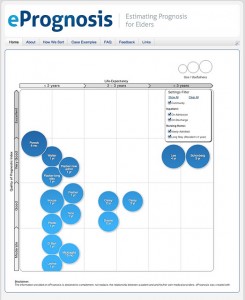Consider this: a woman is hospitalized for pneumonia and her admission chest x-ray shows an “incidental pulmonary nodule,” or a growth in the lungs. Should she receive serial follow-up imaging to determine the presence of cancer?
Of course! She may have cancer, and who wouldn’t want to know for sure and start treating it?
What if the woman is 85 years old with congestive heart failure, chronic kidney disease, chronic malnutrition, and needs help from others to bathe and dress?
 What if, based on these characteristics, you knew her life expectancy and that she will most likely die before a definitive cancer diagnosis and treatment could offer any benefit to her?
What if, based on these characteristics, you knew her life expectancy and that she will most likely die before a definitive cancer diagnosis and treatment could offer any benefit to her?
Add to that her repeated statements about hating the hospital and doctor’s visits, wanting more than anything to spend time at home with her husband, and that the imaging has a risk of false positives and any curative treatment will likely be grueling... Well, you see where I’m heading. The common default--aggressive, diagnose-and-cure-at-all-cost--sometimes doesn’t meet a patient’s real needs or goals. And of course, there is an economic argument to be made for the rational, appropriate use of resources as the country wrestles with reining in rising health care costs.
A new web site, ePrognosis.org, now gives health care providers an additional tool to help them think through and discuss clinical decision-making with older adults, taking into account overall prognosis, or the life expectancy, of their elderly patients. As the excellent Paula Span reports in the New York Times, a group of researchers based at the UCSF Division of Geriatrics developed this free web tool based on their review of 16 evidence-based geriatric prognostic indices, published last week in the Journal of the American Medical Association. (It was a great aging-focused issue; see our blog about Dr. Elizabeth Phelan’s dementia article.) The research team is a “who’s who” of alumni from Hartford Foundation-funded programs. The JAMA paper’s lead author is Lindsey Yourman, now an intern at Scripps Mercy Hospital in San Diego and a former participant in the AFAR/NIA Medical Student Training in Aging Research program. The UCSF team that developed the web site includes Sei Lee, a current Paul B. Beeson Scholar and former Health Outcomes Research Scholar, former T. Franklin Williams Scholar Alex Smith, and colleague Eric Widera (all faculty at the Foundation’s Center of Excellence at UCSF). Mara Schonberg, a past Beeson, Williams, and Health Outcomes Scholar, also collaborated from her faculty position at Beth Israel Deaconess Medical Center/Harvard.
Using the interactive, user-friendly web site developed by these outstanding researchers, health care providers can choose an appropriate prognostic tool based on their patient characteristics and practice setting, plug in patient variables, and get a calculated percentage indicating likelihood of death within a particular time frame. It’s exciting to see research translated into a practical, real-world application. The prognostic indices are all out in publication, but for the busy clinician, they can be difficult to remember, access, and use. This one-stop shop should help.
The researchers caution that the ePrognosis tool is only a rough guide about possible mortality outcomes and should not be the only basis for care decisions. According to the site, “Clinicians should keep in mind that every patient is an individual, and that many factors beyond those used in these indices may influence a patient's prognosis.” The site is a complement, not a replacement, for the patient-provider relationship.
These caveats are important and this work is not without controversy and debate. In fact, I am as impressed with the dialogue fostered by the researchers around this issue as I am with the actual tool. The web site invites feedback via comments and incorporates user ratings on the usefulness of the prognostic indices. The web site tracks related conversations on Twitter and links to the always-informative GeriPal blog (co-founded by Widera and Smith), which has had a lively online debate about overall prognosis in the elderly and related issues around over- and under-utilization of health care services. Dr. Ken Covinsky, Lee’s colleague at UCSF, last week offered a thoughtful and cautionary post (Prognostic Indices In Patient Care: Useful or Waste of Time?), noting that prognostic indices can be of limited accuracy when applied to individuals. He doesn’t dismiss them, but states that like any other clinical tool, they need to be used intelligently.
What’s even more interesting, and in many ways challenging, is the debate among the public. Paula Span previously reported on the researchers’ question of whether to make the site available to the public (it is, although it is presented as a tool for health care providers). The questions are real: “Would non-professionals be apt to misinterpret the numbers? Or to decide that if they had plenty of life expectancy remaining, they might as well smoke?” In asking her readers, they overwhelmingly voted for access and information. Now, however, you find anonymous comments (presumably from the lay public) like: “It smells of 'economic rationalists' deciding on health funding, yet again, to no one's benefit, ” and “It's all about saving $$$$ and getting rid of the useless older, chronically ill, and disabled persons.” I can’t help but think back to the “death panel” debates and how difficult these conversations can be, given our aversion to openly discussing death and the fear that’s been stoked (often politically) around end-of-life care. Still, the debate is absolutely necessary and we must continue to tackle these issues as a country. I’m glad ePrognosis.org and the researchers behind it are prompting this discussion. They are offering clinicians tools and a starting point for having honest, patient-centered, goal-setting conversations with their older patients, and they are inviting clinicians and the public to help make sure the tools are as good as they can be.
